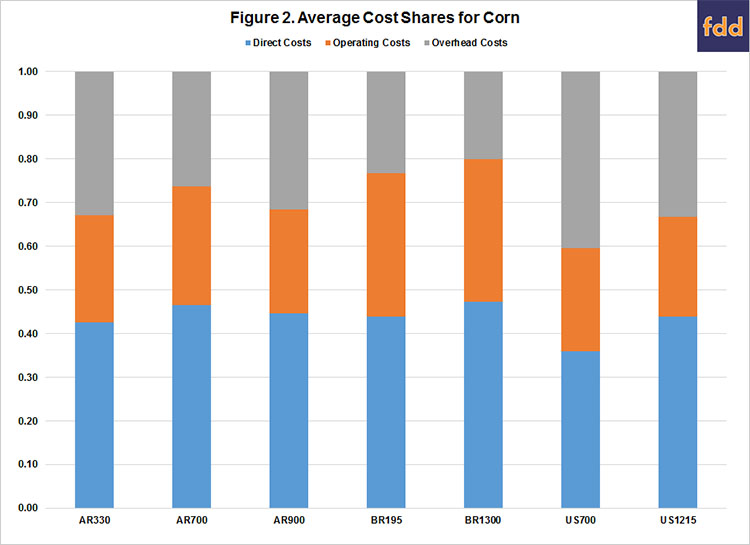International Benchmarks for Corn Production
Examining the competitiveness of corn production in different regions of the world is often difficult due to lack of comparable data and agreement regarding what needs to be measured. To be useful, international data needs to be expressed in common production units and converted to a common currency. Also, production and cost measures need to be consistently defined across production regions or farms.
This paper examines the competitiveness of corn production for important international corn regions using 2012 to 2014 data from the agribenchmark network. This network collects data on beef, cash crops, dairy, pigs and poultry, horticulture, and organic products for 32 countries. The agribenchmark concept of typical farms was developed to understand and compare current farm production systems around the world. Participant countries follow a standard procedure to create typical farms that are representative of national farm output shares, and categorized by production system or combination of enterprises and structural features.
The sample farms used in this paper was comprised of seven typical farms with corn enterprise data from Argentina, Brazil, and United States. It is important to note that corn enterprise data is collected from other countries. These three countries were selected to simplify the illustration of costs and discussion. Analysis for a larger set of countries can be found here.
The farm and country abbreviations used in this paper are listed in table 1. While the farms may produce a variety of crops, this paper only considers corn production. Typical farms used in the agribenchmark network are defined using country initials and hectares on the farm. There are five U.S. farms with corn in the network. The two farms used to illustrate corn production in this paper are the Iowa farm (US700) and a farm in west central Indiana (US1215).

Corn Yields
Although yield is only a partial gauge of performance, it reflects the available production technology across farms. Average corn yield for the farms in 2012 to 2014 was 7.85 metric tons per hectare (125 bushels per acre). Average farm yields ranged from approximately 5.79 metric tons per hectare for one of the Brazilian farms (92 bushels per acre) to 10.75 metric tons per hectare for the Iowa farm (171 bushels per acre). Figure 1 illustrates average corn yield for each typical farm. Both of the U.S. farms had average corn yields above 10 metric tons per hectare (159 bushels per acre).

Input Cost Shares
Due to differences in technology adoption, input prices, fertility levels, efficiency of farm operators, trade policy restrictions, exchange rate effects, and labor and capital market constraints, input use varies across corn farms. Figure 2 presents the average input cost shares for each farm. Cost shares were broken down into three major categories: direct costs, operating costs, and overhead costs. Direct costs included seed, fertilizer, crop protection, crop insurance, and interest on these cost items. Operating cost included labor, machinery depreciation and interest, fuel, and repairs. Overhead cost included land, building depreciation and interest, property taxes, general insurance, and miscellaneous cost.

The average input cost shares were 43.5 percent for direct cost, 26.7 percent for operating cost, and 29.7 percent for overhead cost. The U.S. farms had below average cost shares for direct cost and operating cost, and an above average cost share for overhead cost. The relatively large cost share for overhead cost in the U.S. reflects our relatively high land cost.
Revenue and Cost
Figure 3 presents average gross revenue and cost for each typical farm. Gross revenue and cost are reported as U.S. dollars per hectare. The corn enterprise is a relatively minor enterprise for the three typical farms in Argentina and the smallest Brazilian typical farm (BR195) so comparisons will focus on the largest typical farm from Brazil (BR1300) and the two typical farms from the United States. It is obvious from figure 3 that gross revenue per hectare is substantially higher for the two U.S. farms. However, cost is also substantially higher for these two farms. Average economic profit for the farm from Indiana was $13 per hectare ($5 per acre). The largest Brazilian farm and the farm from Iowa (US700) lost $122 and $32 per hectare ($49 and $13 per acre), respectively.

The largest Brazilian farm and the two U.S. farms had an economic profit in 2012 (see figure 4). However, these three farms had economic losses in 2013 and 2014. Economic losses were particularly large in 2014. For this year, losses for the BR1300, US700, and US1215 typical farms were $189, $390, and $193 per hectare ($76, $158, and 78 per acre), respectively. Due to having a lower gross revenue, economic losses as a percent of gross income were much larger for the Brazilian farm.

Conclusions
This paper examined the yields, gross revenue, and cost for farms in the agribenchmark network from Argentina, Brazil, and the United States. Yield, gross revenue, and cost were substantially higher for the U.S. farms. The three farms from Argentina and one of the U.S. farms had an average economic profit during the 2012 to 2014 period. Gross revenue and profitability has dropped substantially since 2012. All of the typical farms face challenges in this new price environment.
References
E. Lunik and M. Langemeier. "International Benchmarks for Corn Production." Purdue Agriculture Center for Commercial Agriculture, June 2015. https://ag.purdue.edu/commercialag/Pages/Resources/Management-Strategy/International-Benchmarks/International-Benchmarks-Corn.aspx
Disclaimer: We request all readers, electronic media and others follow our citation guidelines when re-posting articles from farmdoc daily. Guidelines are available here. The farmdoc daily website falls under University of Illinois copyright and intellectual property rights. For a detailed statement, please see the University of Illinois Copyright Information and Policies here.







